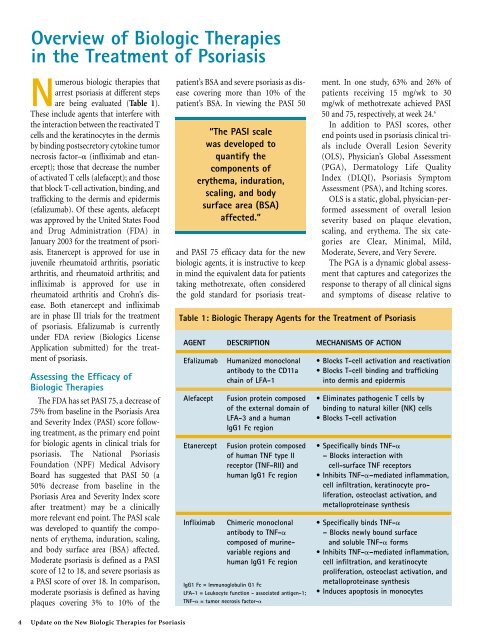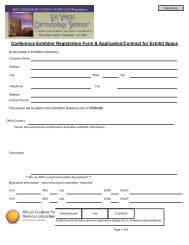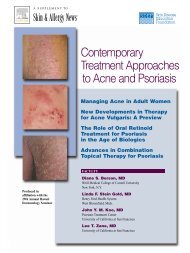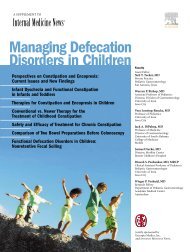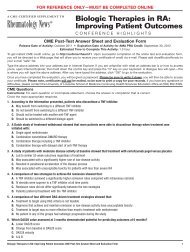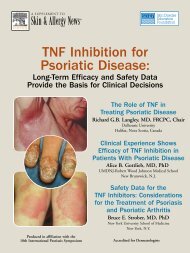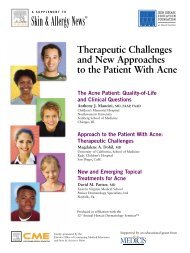Overview Of Psoriasis - Global Academy for Medical Education
Overview Of Psoriasis - Global Academy for Medical Education
Overview Of Psoriasis - Global Academy for Medical Education
You also want an ePaper? Increase the reach of your titles
YUMPU automatically turns print PDFs into web optimized ePapers that Google loves.
<strong>Overview</strong> of Biologic Therapies<br />
in the Treatment of <strong>Psoriasis</strong><br />
Numerous biologic therapies that<br />
arrest psoriasis at different steps<br />
are being evaluated (Table 1).<br />
These include agents that interfere with<br />
the interaction between the reactivated T<br />
cells and the keratinocytes in the dermis<br />
by binding postsecretory cytokine tumor<br />
necrosis factor– (infliximab and etanercept);<br />
those that decrease the number<br />
of activated T cells (alefacept); and those<br />
that block T-cell activation, binding, and<br />
trafficking to the dermis and epidermis<br />
(efalizumab). <strong>Of</strong> these agents, alefacept<br />
was approved by the United States Food<br />
and Drug Administration (FDA) in<br />
January 2003 <strong>for</strong> the treatment of psoriasis.<br />
Etanercept is approved <strong>for</strong> use in<br />
juvenile rheumatoid arthritis, psoriatic<br />
arthritis, and rheumatoid arthritis; and<br />
infliximab is approved <strong>for</strong> use in<br />
rheumatoid arthritis and Crohn’s disease.<br />
Both etanercept and infliximab<br />
are in phase III trials <strong>for</strong> the treatment<br />
of psoriasis. Efalizumab is currently<br />
under FDA review (Biologics License<br />
Application submitted) <strong>for</strong> the treatment<br />
of psoriasis.<br />
Assessing the Efficacy of<br />
Biologic Therapies<br />
The FDA has set PASI 75, a decrease of<br />
75% from baseline in the <strong>Psoriasis</strong> Area<br />
and Severity Index (PASI) score following<br />
treatment, as the primary end point<br />
<strong>for</strong> biologic agents in clinical trials <strong>for</strong><br />
psoriasis. The National <strong>Psoriasis</strong><br />
Foundation (NPF) <strong>Medical</strong> Advisory<br />
Board has suggested that PASI 50 (a<br />
50% decrease from baseline in the<br />
<strong>Psoriasis</strong> Area and Severity Index score<br />
after treatment) may be a clinically<br />
more relevant end point. The PASI scale<br />
was developed to quantify the components<br />
of erythema, induration, scaling,<br />
and body surface area (BSA) affected.<br />
Moderate psoriasis is defined as a PASI<br />
score of 12 to 18, and severe psoriasis as<br />
a PASI score of over 18. In comparison,<br />
moderate psoriasis is defined as having<br />
plaques covering 3% to 10% of the<br />
patient’s BSA and severe psoriasis as disease<br />
covering more than 10% of the<br />
patient’s BSA. In viewing the PASI 50<br />
“The PASI scale<br />
was developed to<br />
quantify the<br />
components of<br />
erythema, induration,<br />
scaling, and body<br />
surface area (BSA)<br />
affected.”<br />
and PASI 75 efficacy data <strong>for</strong> the new<br />
biologic agents, it is instructive to keep<br />
in mind the equivalent data <strong>for</strong> patients<br />
taking methotrexate, often considered<br />
the gold standard <strong>for</strong> psoriasis treatment.<br />
In one study, 63% and 26% of<br />
patients receiving 15 mg/wk to 30<br />
mg/wk of methotrexate achieved PASI<br />
50 and 75, respectively, at week 24. 6<br />
In addition to PASI scores, other<br />
end points used in psoriasis clinical trials<br />
include Overall Lesion Severity<br />
(OLS), Physician’s <strong>Global</strong> Assessment<br />
(PGA), Dermatology Life Quality<br />
Index (DLQI), <strong>Psoriasis</strong> Symptom<br />
Assessment (PSA), and Itching scores.<br />
OLS is a static, global, physician-per<strong>for</strong>med<br />
assessment of overall lesion<br />
severity based on plaque elevation,<br />
scaling, and erythema. The six categories<br />
are Clear, Minimal, Mild,<br />
Moderate, Severe, and Very Severe.<br />
The PGA is a dynamic global assessment<br />
that captures and categorizes the<br />
response to therapy of all clinical signs<br />
and symptoms of disease relative to<br />
Table 1: Biologic Therapy Agents <strong>for</strong> the Treatment of <strong>Psoriasis</strong><br />
AGENT DESCRIPTION MECHANISMS OF ACTION<br />
Efalizumab Humanized monoclonal • Blocks T-cell activation and reactivation<br />
antibody to the CD11a • Blocks T-cell binding and trafficking<br />
chain of LFA-1<br />
into dermis and epidermis<br />
Alefacept Fusion protein composed • Eliminates pathogenic T cells by<br />
of the external domain of binding to natural killer (NK) cells<br />
LFA-3 and a human • Blocks T-cell activation<br />
IgG1 Fc region<br />
Etanercept Fusion protein composed • Specifically binds TNF-<br />
of human TNF type II – Blocks interaction with<br />
receptor (TNF-RII) and cell-surface TNF receptors<br />
human IgG1 Fc region • Inhibits TNF-–mediated inflammation,<br />
cell infiltration, keratinocyte proliferation,<br />
osteoclast activation, and<br />
metalloproteinase synthesis<br />
Infliximab Chimeric monoclonal • Specifically binds TNF-<br />
antibody to TNF- – Blocks newly bound surface<br />
composed of murine- and soluble TNF- <strong>for</strong>ms<br />
variable regions and • Inhibits TNF-–mediated inflammation,<br />
human IgG1 Fc region cell infiltration, and keratinocyte<br />
proliferation, osteoclast activation, and<br />
metalloproteinase synthesis<br />
• Induces apoptosis in monocytes<br />
IgG1 Fc = Immunoglobulin G1 Fc<br />
LFA-1 = Leukocyte function - associated antigen-1;<br />
TNF- = tumor necrosis factor-<br />
4 Update on the New Biologic Therapies <strong>for</strong> <strong>Psoriasis</strong>


